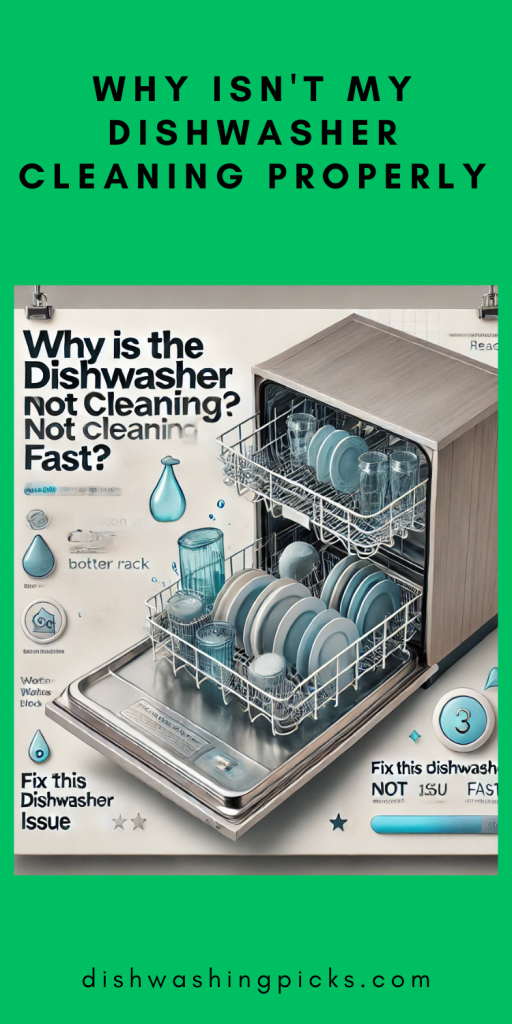You load up your dishwasher, press start, and go about your day, expecting to return to sparkling clean dishes. But when you open the door? You’re greeted with greasy plates, cloudy glasses, and food bits stubbornly clinging on for dear life. Ugh! What went wrong?
If your dishwasher isn’t cleaning properly, don’t panic. There are a few common culprits behind the issue—and the good news? Most of them have easy fixes! Let’s break it down.
1. Clogged Spray Arms: The Water Isn’t Reaching Your Dishes
Your dishwasher’s spray arms are responsible for blasting water onto your dishes. But if those little holes in the arms get clogged with food debris or hard water buildup, the water pressure drops, and your dishes stay dirty.
🔧 How to Fix It:
- Remove the spray arms and check for blockages.
- Use a toothpick or a small brush to clear out any gunk.
- If you see mineral buildup (hello, hard water!), soak the spray arms in vinegar for 20-30 minutes.
2. Overloading the Dishwasher: Are You Stuffing It Like a Suitcase?
We get it—dishwashers save time, so why not load it up to the max, right? Well, cramming in too many dishes can actually prevent water and detergent from reaching everything properly.
🛠 How to Fix It:
- Give your dishes some breathing room! Arrange them so water can circulate freely.
- Avoid nesting bowls or stacking utensils too tightly.
👉 Pro tip: Make sure nothing is blocking the spray arms from spinning. A large pan or cutting board in the wrong spot can totally mess up the cleaning process.
3. Dirty Filters: The Secret Trap for Food Gunk
Did you know your dishwasher has a filter? Many people don’t! If it’s clogged with food debris, grease, or soap scum, your dishwasher won’t clean as effectively.
🔧 How to Fix It:
- Locate the filter (usually at the bottom of the dishwasher).
- Rinse it under warm water and scrub off any residue with a soft brush.
- If it’s really grimy, soak it in soapy water for 10-15 minutes before rinsing.
👉 Pro tip: Clean your filter once a month to keep your dishwasher working at its best!
4. Low Water Temperature: Cold Water Won’t Cut It
Hot water is crucial for breaking down grease and grime. If your dishwasher isn’t getting enough hot water, your dishes won’t come out as clean as they should.
🌡 How to Fix It:
- Check your water heater temperature—it should be set to at least 120°F (49°C).
- Run the kitchen sink with hot water before starting the dishwasher to ensure it gets hot water right away.
5. Using the Wrong Detergent (Or Not Enough of It!)
Believe it or not, the type and amount of detergent you use can make a huge difference.
🧼 How to Fix It:
- Use high-quality dishwasher detergent—cheap brands can leave residue behind.
- If you have hard water, consider using a detergent with a built-in rinse aid.
- Don’t overdo it! Too much detergent can leave a soapy film on your dishes.
6. Hard Water Buildup: The Silent Dishwasher Killer
If your dishes have a chalky residue or look cloudy, hard water could be the culprit. The minerals in hard water can leave behind deposits that affect cleaning performance.
💧 How to Fix It:
- Use a dishwasher cleaner or run an empty cycle with white vinegar to break down mineral buildup.
- If hard water is a recurring issue, consider adding a water softener to your home.
7. A Failing Water Inlet Valve: The Dishwasher’s Water Supply Might Be Weak
The water inlet valve controls the amount of water entering your dishwasher. If it’s clogged or malfunctioning, your dishwasher might not be getting enough water to clean properly.
🛠 How to Fix It:
- If your dishwasher sounds like it’s struggling to fill with water, the inlet valve could be blocked.
- You might need a professional to inspect or replace it if it’s failing.
Final Thoughts: Get Your Dishwasher Back in Action!
If your dishwasher isn’t cleaning properly, don’t rush to replace it just yet! A little troubleshooting can go a long way. Here’s a quick recap of what to check:
✅ Spray arms – Make sure they’re not clogged.
✅ Loading technique – Don’t overload the dishwasher.
✅ Filter – Clean it regularly.
✅ Water temperature – Ensure it’s hot enough.
✅ Detergent – Use the right type and amount.
✅ Hard water buildup – Clean with vinegar if necessary.
✅ Water inlet valve – Inspect if the water supply seems weak.
Try these fixes, and you’ll be back to sparkling clean dishes in no time! If none of these work, it might be time to call in a professional for a deeper look.

